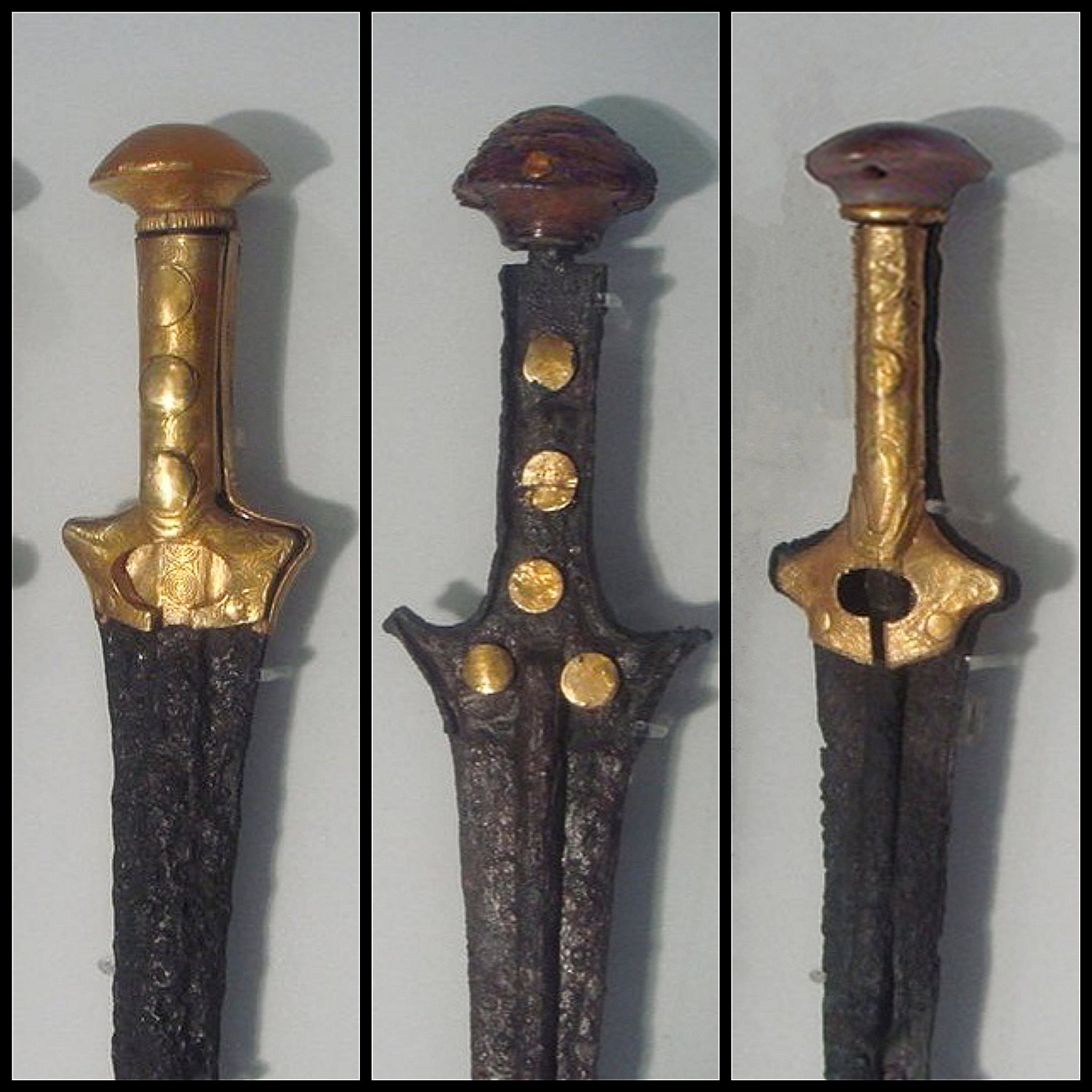Mycenaean Swords with elaborate ‘Gold Plating’ (1600-1300 BC), from Crete, Greece.
Mycenaean dagger, gold and iron, detail, National Archaeological Museum of Athens, 8710, Athens. Courtesy of Wikimedia Commons contributor Jebulon.
The military nature of the Mycenaean Greeks is evident from the numerous weapons unearthed, the use of warrior and combat representations in contemporary art, and the preserved Greek Linear B records. The Mycenaeans invested in the development of military infrastructure, with military production and logistics being supervised directly from the palatial centers. According to the Linear B records in the palace of Pylos, every rural community (the damos) was obliged to supply a certain number of men who had to serve in the army. Similar service was also performed by the aristocracy.
Mycenaean armies were initially based on heavy infantry, equipped with spears, large shields and in some occasion armor. Later in the 13th century BC, Mycenaean warfare underwent major changes both in tactics and weaponry and armed units became more uniform and flexible, while weapons became smaller and lighter. The spear remained the main weapon among Mycenaean warriors, while the sword played a secondary role in combat. Other offensive weapons used were bows, maces, axes, slings and javelins. The precise role and contribution of chariots on the battlefield is a matter of dispute due to the lack of sufficient evidence. It appears that chariots were initially used as fighting vehicles during the 16th to 14th centuries BC, while later, in the 13th century BC, their role was limited to battlefield transport.
The boar’s tusk helmet was the most identifiable piece of Mycenaean armor in use from the beginning to the collapse of Mycenaean culture. It is also known from several depictions in contemporary art in Greece and the Mediterranean. A representative piece of Mycenaean armor is the Dendra panoply (c. 1450–1400 BC) which consisted of a cuirass of a complete set of armor made up of several elements of bronze. In general, most features of the later hoplite panoply of classical Greek antiquity, were already known to Mycenaean Greece. “Figure-of-eight” shields were the most common type of Mycenaean shields. During the Late Mycenaean period, smaller types of shields were adopted, either of completely circular shape, or almost circular with a part cut out from their lower edge.
The fabled Agamemnon, King of Mycenae, was the commander-in-chief of the Greeks during the Trojan War. During the fighting, Agamemnon killed Antiphus and fifteen other Trojan soldiers, according to one source. But in the “Iliad” itself, he’s shown to slaughter hundreds more in Book 11 during his aristea loosely translated to “day of glory” which is the most similar to Achilles’ aristea in Book 21 (they both are compared to lions and destructive fires in battle, their hands are described as “splattered with gore” and “invincible,” the Trojans flee to the walls, they both are appealed to by one of their victims, they are both avoided by Hector, they both get wounded in the arm or hand, and they both kill the one who wounded them). Even before his aristea, Agamemnon was considered to be one of the three best warriors on the Greek side as proven when Hector challenges any champion of the Greek side to fight him in Book 7, and Agamemnon (along with Diomedes and Big Aias) is one of the three most wished for to face him out of the nine strongest Greek warriors who volunteered. And after they reconciled, even Achilles admits in Book 23 that Agamemnon is “the best in strength and in throwing the spear.” That claim is further proven by the fact that Agamemnon was the only major warrior on either side never to need the gods’ direct intervention to increase his strength or give him any unfair advantages in battle and yet he still caused incredible destruction almost on the scale of Achilles.
Boar’s tusk helmet with cheek-guards and a double bone hook on top. Mycenae, chamber Tomb 515, 14th – 13th cents. BCE at the National Archaeological Museum of Athens courtesy of Wikimedia Commons contributor Jebulon.
Special daggers (ceremonial?) with semiprecious blade. Mycenae, Grave 88. Late Bronze Age. National Archaeological Museum of Athens. Courtesy of Wikimedia Commons contributor Zde.
Mycenaen sword reconstructions from fragments in the Archaeological Museum in Athens. Courtesy of Wikimedia Commons contributor JanMad.
Mycenaean bronze swords, found in the tomb V of Mycenae, 16th century BCE. National Archaeological Museum of Athens. Courtesy of Wikimedia Commons contributor Dorieo.
Mycenean helmet with punched decoration, 1400-1300 BC Displayed at the Ashmolean Museum, Oxford courtesy of Wikimedia Commons contributor Gts-tg.
Related Post
A shocking documentary proves that mermaids do exist
SHOCKING Revelation: Thuya, Mother of Queen Tiye, Was the Grandmother of Akhenaten and Tutankhamun—What Ancient Egyptian Secrets Did She Leave Behind?
Breaking News: Astonishing Discoveries at Karahan Tepe Confirm an Extraterrestrial Civilization is Hiding on Earth, and NO ONE Knows!
Breaking News: Researchers FINALLY Discover U.S. Navy Flight 19 After 75 Years Lost in the Bermuda Triangle!
NASA’s Secret Investigation: Uncovering the Astonishing Mystery of the UFO Crash on the Mountain!
Explosive UFO Docs LEAKED: Startling Proof That Aliens Ruled Ancient Egypt!



